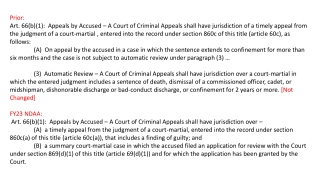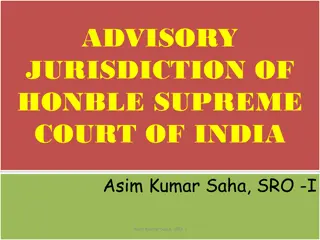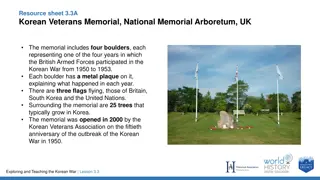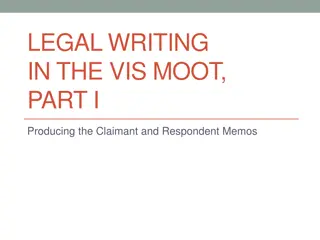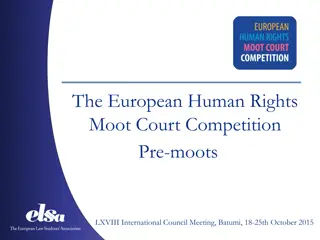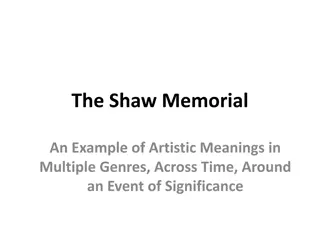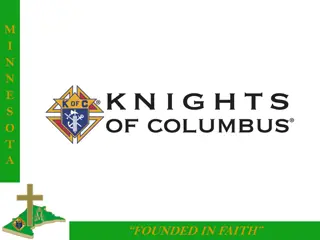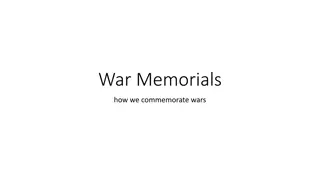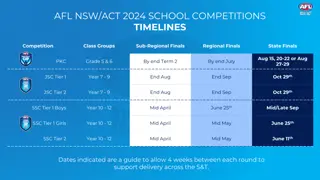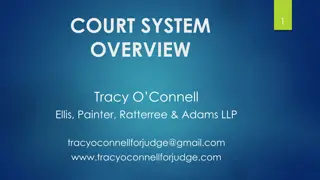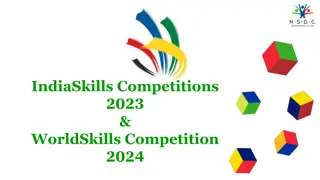Guide to Structuring a Memorial for Moot Court Competitions
A memorandum, or memo, is crucial for communicating agreements in negotiations. To draft an effective memorial for moot court competitions, one must ensure proper structuring, starting with reading and research. Key components include the cover page, table of contents, and index of authorities. Clear guidelines on formatting and content help in presenting a solid argument.
Uploaded on Oct 07, 2024 | 0 Views
Download Presentation

Please find below an Image/Link to download the presentation.
The content on the website is provided AS IS for your information and personal use only. It may not be sold, licensed, or shared on other websites without obtaining consent from the author. Download presentation by click this link. If you encounter any issues during the download, it is possible that the publisher has removed the file from their server.
E N D
Presentation Transcript
INTRODUCTION A memorandum (memo) is a document used to clearly and concisely convey important changes or agreements that were made during the negotiations process. The intent of the memo is to explain why the agreements you made and the final contract you drafted is fair and good for your side. How the memorandum is structured depends on certain factors, including: The purpose of the memorandum The reader's needs The nature of the situation or problem Legal findings Subject logic The range of research A standard approach
CONTENTS OF MEMORIAL The best way to start a memorial is to read the problem as many times as you can and clear up your basic regarding the topic involved in proposition. A lot of reading skill is required. Your initial reading will give you a lot of insight as to how to go about the entire research and then accordingly members can divide their work. Firstly, issues should be decided and divided among team members. It is very important to maintain a constant coordination regarding the research involved and keep on discussing various lines of arguments. It will make the work easier for all the team members and then all members can carry out their work accordingly. Every moot, like every court proceeding, has two sides, the appellants and the respondents. Usually you have to prepare for both sides. A Moot team comprises of, generally, 2 speakers and 1 researcher. Every moot has 2 aspects you are judged on. They are: Written submission called the memorial Oral submission The written submission of memorial must contain the following things.
COVER PAGE The cover page of each written submission of Memorial must have the following information: The name of the forum before which the proceedings are being conducted; 1)The title of the competition; 2)The name of the case; 3)The Title of the Memorial ( Memorial submitted on behalf of the Plaintiff or Petitioner or Appellant or Memorial submitted on behalf of the Defendant or Respondent or Respondent ). 4)The cover pages must be Blue for Plaintiff or Petitioner or Appellant and Red for Defendant or Respondent or Respondent. Plaintiff (Blue) v. Defendant (Red); Petitioner (Blue) v. Respondent (Red); Appellant (Blue) v. Respondent (Red); The upper right side of the cover page must contain the Team Code that shall be assigned to each participating teams during Registration. Names of Participants, or Colleges or Universities should not to be mentioned anywhere on the Written Submission of Memorial (you should check the specific rules regarding this though).
TABLE OF CONTENTS It contains a list of chapters and paragraphs that are included in the memorial. We can also mention page numbers of chapters and paragraphs. By mentioning page numbers it will be easy for the judges and speakers to find out the mentioned arguments. The argument is the most complex part of the brief. Therefore, subheadings used within section should also be listed in the Table of Contents with the number. the headings the and argument corresponding page
INDEX OF AUTHORITIES In this all the materials which support your argument have to be added. The authorities of Supreme Court and High courts, foreign judgments, statutes, and parliamentary debates are mentioned under the index of authorities. Sources refer through articles, text books, journals, mentioned. This is not only helpful for the speaker but also useful for the judge and other side speaker to easily determine what case laws, constitutional provisions, statutes or other materials are being cited. Uniform citation method has to be followed. Citation is crucial part of memorial; it should be in correct format. Citation helps to determine from where the certain cases, statutes or other materials have been taken. It gives easily reference to the judges from where certain part has been taken. and websites are also
LIST OF ABBREVIATIONS It should contain all the abbreviations used in your memorial. Each abbreviation should contain the full meaning and in whole memorial same abbreviation followed. It is also necessary for the speaker to know what abbreviations they are citing in their memorial. should be
STATEMENT OF JURISDICTION Jurisdiction is the most important part of memorial. The jurisdiction of the court should be clearly mentioned with the reason. Finding the proper important. Judges surely ask questions and thereby it is important jurisdiction of the court. jurisdiction is very to know the
STATEMENT OF FACTS/ SYNOPSIS OF FACTS These statements of facts/ synopsis of facts are an important part in memorial presentation. It generally convinces the court about your client s position and its point of view. A judge may be well versed in law but he doesn t know about the facts of your particular case. So, a brief summary of facts have to be written clearly in the beginning of the memorial but generally it should not be more than two pages. Knowing of facts in brief is very necessary, so it is important for a speaker to go through the facts carefully and only relevant facts should be mentioned in your memorial. Facts should not be uninteresting. It should be in a manner that a person enjoys reading and it proves on your side. The facts should not be assumed one; it should be real as given in the proposition.
STATEMENT OF ISSUES This is a short introductory statement of the legal issues or points of law involved in the case. It tells the judges precisely what legal issues the speaker wants the court to decide. These statements should be phrased to help one to argue for a particular conclusion rather than simply against the other side. These issues are stated in question form and should be phrased in such a way that it showed on its favour side. These issues are very short and not lengthy so as to make an individual understand the very essence of it. They are not more than one sentence. The sentence Whether and end up with the Question mark . should start with
SUMMARY OF ARGUMENTS This is a brief summary of arguments based on the issues raised. It is short introductory of issues mentioned in your memorial and each argument should not be more than one paragraph. It only shows what you are arguing for in brief.
ARGUMENTS ADVANCED This is the heart and soul of the memorial. Every part of the argument must be supported by legal authority. Arguments should be well-organized and convincing. Each point the team wants the court to consider in deciding the case must be described, the reasons explained with appropriate references to research materials used, and text citations should be inserted as frequently as needed. Arguments should address legal precedent and policy issues. Each part of the argument first addresses the issues supporting one s own case. Then, address contentions anticipated to be brought up by the opposing party. The argument should be written in forceful, active, positive language. It is best to avoid the passive tense. Headings and subheadings are used to help in clearly organizing the arguments. The same structure of headings and subheadings should be summarized in the Table of Contents. The idea is to do everything in terms of both form and substance to help the court understand the reasonableness and logic of the argument, and thus decide in one s favor.
PRAYER It is the relief claimed by the parties which should be clearly mentioned. More than one relief can be claimed in one cause of action. Following the prayer signature of the council must be stated. This acts as the ending of the Memorial. This clearly declares what an individual be it a petitioner or the defendant actually wants from the Court in his favor. This is the relief mentioning sentence, and in it the basic motive of filing the suit is mentioned through reliefs claimed.
CONCLUSION Memorial writing is an art of writing. For writing a proper memorial one has to be thorough not only with the facts but also with the laws that have to be applied. It is a tedious task and mooting altogether involves many of such tedious tasks. This was just about the Memorial writing, but for insights about various other aspects of Mooting. If an individual knows the facts very well but does not know what all laws have to be applied, the facts known will act as null and void. Before making the memorial or start up with his work one should get well versed with the particular area of law which is going to be applied because a single memorial does not contain a single law but a series of laws from various sources. A proper knowledge as well as patience is needed in making a good or even the best memorial. A person cannot complete his memorial in one or two weeks but need a months time to draft his memorial.


